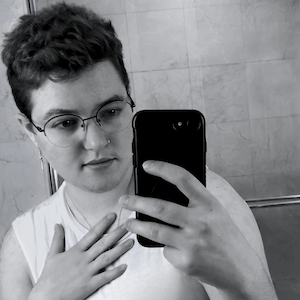JCURA projects

The Jamie Cassels Undergraduate Research Awards (JCURA) offer an opportunity for exceptional undergraduate students to obtain direct research experience through completion of a research project and poster.
Medieval Studies 2023-24 JCURA psoters:
Enchanted Avians: Catalogying & Interpresting Birds' Presences in Medieval Welsh Literature
by Sarah Evans
Thirteenth-Century Echoes Today: Le Roman de Silence and Queer Medieval Studies
by Alexander J. Wolffe
2020 - 2021 JCURA Students
Soph Dunn-Krahn
Gender Transgressive Figures in Medieval and Early Modern Texts
Figures who transgress gender boundaries are portrayed in medieval and early modern literature, anthropological texts and medical texts, often as distinct groups characterized by their anatomy and behavior. Some examples include the often monstrous ‘hermaphrodite,’ and the Renaissance’s spiritual equivalent, the ‘androgyne’; one group of tales tells a number of stories of female people who, for various reasons, spontaneously become male; another figure is the ‘Tribade’ or ‘Fracatrix’ who engages in same-sex erotic behavior, and whose abnormality, like the hermaphrodites,’ is attributed to variant anatomy; there are stories about people who, while viewed as anatomically stable by the authors of the texts, are transgressive in their behavior, taking on the role of the ‘opposite’ gender. My research will collect some of these narratives, investigate this constructed typology based on externally recognizable characteristics, and examine how these characteristics - anatomy and behavior - overlap and interact in the construction of these types. Ultimately, I will attempt to trace potential similarities of queer experience between contemporary and early modern people while at the same time resisting anachronistic imposition of current understandings onto medieval texts, posing the question: can we usefully export the concept of queerness onto medieval and early-modern texts?
Mikkel Klausen
Berserkr as Defined Through the Prose Edda
In the compilation of sagas known as the Prose Edda (or the Younger Edda), Snorri Sturluson enhances the prior conception of berserkr, a person from medieval Scandinavia who used rage for combat purposes. Put together circa 1220, these sagas contain many figures referred to either explicitly or implicitly as berserkr. Due to the traditional oral nature of the sagas, the precise age of the works and their subsequent authors are difficult to determine. At best it may be theorized that Sturluson remixed and refashioned a number of the sagas himself, as did the poets before him. Although artistic expressions of contemporary events, the pieces are rooted in actual historical events. By analyzing the Prose Edda, I will argue that the sagas expand the modern perception of berserkr. I will explore the contribution of substance use, such as the consumption of Fly Agaric mushrooms, as one method to affect with chemicals the berserker’s state of mind, specifically to produce rage. The aim of this research project is to elaborate on the definition of berserkr by close analysis of numerous figures in the Prose Edda. An examination of relevant historical contexts such as cultural expectations, religion, political environments, and the effects on the human body of substances that were used in medieval Scandinavia, will be included.
2019 JCURA Student - Emma Robertson
Hounds, Guardians, and Oracles: Dogs as symbols of the Middle Ages
Looking at medieval art, profane and sacred, at funerary sculptures, at drawings in the margins of manuscripts, at paintings or stained glass, one will encounter many dogs: of different sizes, colors, positions, and postures, they hold different symbolisms, representing in their contexts either loyalty or ferocity, either guardianship or aggression. The values and stories associated with dogs, a familiar pet but also a fearsome guardian and defender, intertwine classical myths inherited from Antiquity and Christian references.
Often evoked as a way to reflect human qualities which one should either fear or emulate, they also linked human beings and gods, keeping the gates of the underworld or guiding the souls of the departed to their afterlives. Dogs held sacred power as well as familiar values. This complexity offers an opportunity for the analysis of an aspect of medieval culture: the synthesis of symbols and representations from different cultures.
Through the use of primary sources —the Bible, European mythologies, medieval bestiaries, works of art— and secondary sources —works on animals in medieval art and culture —, the symbolic ambivalence of dogs as representations of friends, foes, and forewarnings will be explored. How can one recognize which type of symbolism to choose in a specific context: what is the significance of colour? of species? of posture? Which are the conventions to depict the good and bad dogs? Ultimately, are these medieval symbols still informing our own perception of dogs as symbolic representations?
View the full poster.
2018 JCURA student - Duncan Calveley
Amber in the Tomb; a connection between the Khitan and the Chinese afterlife.
"The tomb of the Princess of Chen of the Liao Dynasty of China, buried in the 11th century, contains an unusually high quantity of amber. The Liao Dynasty, ruled and founded by the Khitan people, was in the process of adopting Chinese cultural practices, including burial practices, which differs greatly from traditional Khitan burial and death practices. The Princess of Chen was buried in a Chinese way, incorporating some burial practices of the earlier golden age of China, the Tang dynasty (618-907 CE). Placing the contents of the tomb of the Princess of Chen in the context of the contents earlier Chinese Tang tombs, contemporary Chinese Song (960-1279 CE) tombs, and the relationship between the Khitan people and the Chinese Empires, I aim to answer two questions. First, what does the contents of the Khitan Liao tombs, with focus on the amber, tell us about the Liao culture with regards to adopting and adapting Chinese customs and holding onto old traditions? Second, what was the significance of the presence of the amber to the Khitan Liao people, and to the Royal court at the time of the death of the princess? I am focusing on analysing the contents of the Tomb of the Princess of Chen, while also analysing contents of other Liao, Tang, and Song tombs for comparison between cultures."
Faculty supervisor: Dr. Tsung-Cheng Lin
This year the JCURA fair will be held on Wednesday March 7th from 11:30 - 3:00 in the UVic Student Union Building.
Opening remarks will be in the Michele Pujol Room.
2014 JCURA Presentations
This year, medieval studies student Jennifer McClean presented a poster titled "From Nymph to Maiden: The Lady of the Lake as Narrative Shape-shifter" and fellow medieval studies student Josef Méthot presented a poster exploring the role and impact of the Cistercian Order in Southern France.


